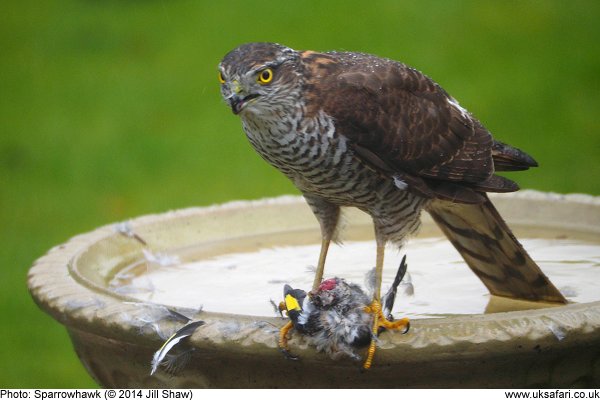 Sparrowhawks
SparrowhawksIdentify It > Bird Section > Birds of Prey Section > Sparrowhawks >

Scientific name: Accipiter nisus
Size: Approx 30 to 35cm
Distribution: Found in most parts of the U.K.
Months seen: All year round
Habitat: Parks, woods and open country. Frequently hunts in urban gardens
Food: Small birds, mice, frogs and insects
Special features: Sparrowhawks are the UK's second most common bird of prey (after the kestrel). They're quite a secretive bird. The first sighting most people have of this bird is often a shocking one, as it swoops down to snatch a small bird from their garden bird feeder.
The male sparrowhawk is almost half the weight of the female and has an orange-red tinge to his cheeks and barred breast. The female is more brown in colour. Sparrowhawks have long legs, broad rounded wings and a long tail.
When hunting they will often perch some distance from their prey in a concealed place before launching a surprise attack. Occasionally you'll catch a glimpse of one as it flashes by to snatch a small bird in its powerful talons. They come shooting in, like a precision guided missile, pluck the bird off it's perch, or out of the air, and fly off with it.

A pile of neatly plucked, unbroken feathers is often a sign that a sparrowhawk is in the area. If the feathers are torn and broken it's more likely to have been the work of a fox.
 Related Pages
Related Pages

 Popular Pages
Popular PagesAmphibians, Bats, Badgers, Beetles, Birds, Birds of Prey, Bumble Bees, Butterflies, Caterpillars, Climate Change, Deadly Spiders, False Widow Spiders, Frogs, Garden Spiders, Glow-Worms, Hedgehogs, House Spiders, Owls, Spiders, Toads, What's Out Now?
Copyright © 2024 G. Bradley UK Safari. All rights reserved | About Us | Links | Advertise | Contributors